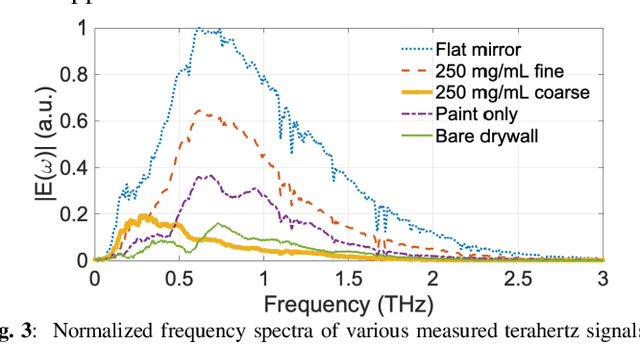Karl Strecker
Comparison of Experimental and Theoretical Mechanical Jitter in a THz Communication Link
Mar 05, 2025Abstract:The effect of mechanical vibration (jitter) is an increasingly important parameter for next-generation, long-distance wireless communication links and the channel models used for their engineering. Existing investigations of jitter effects on the terahertz (THz) backhaul channel are theoretical and derived primarily from free space optical models. These lack an empirical and validated treatment of the true statistical nature of antenna motion. We present novel experimental data which reveals that the statistical nature of mechanical jitter in 6G links is more complex than previously assumed. An unexpected multimodal distribution is discovered, which cannot be fit with the commonly cited model. These results compel the refinement of THz channel models under jitter and the resulting system performance metrics.
A Perspective on the Impact of Group Delay Dispersion in Future Terahertz Wireless Systems
May 30, 2024Abstract:This article discusses the challenges and opportunities of managing group delay dispersion (GDD) and its relation to the performance standards of future sixth-generation (6G) wireless communication systems utilizing terahertz frequency waves. The unique susceptibilities of 6G systems to GDD are described, along with a quantitative description of the sources of GDD, including multipath, rough surface scattering, intelligent reflecting surfaces, and propagation through the atmosphere. An experimental case-study is presented that confirms previous models quantifying the impact of atmospheric GDD. Several GDD manipulation strategies are presented illustrating their hindered effectiveness in the 6G context. Conversely, some benefits of leveraging GDD to enhance 6G systems, such as improved security and simplified hardware, are also discussed. Finally, a perspective on using photonic GDD control devices is provided, revealing quantitative benefits that may unburden existing equalization schemes. The article argues that GDD will uniquely and significantly impact some 6G systems, but that its careful consideration along with new mitigation strategies, including photonic devices, will help optimize system performance. The conclusion provides a perspective to guide future research in this area.
Fundamental Performance Limits on Terahertz Wireless Links Imposed by Group Velocity Dispersion
Apr 26, 2021



Abstract:A theoretical framework and numerical simulations quantifying the impact of atmospheric group velocity dispersion on wireless terahertz communication link error rate were developed based upon experimental work. We present, for the first time, predictions of symbol error rate as a function of link distance, signal bandwidth, signal-to-noise ratio, and atmospheric conditions, revealing that long-distance, broadband terahertz communication systems may be limited by inter-symbol interference stemming from group velocity dispersion, rather than attenuation. In such dispersion limited links, increasing signal strength does not improve the symbol error rate and, consequently, theoretical predictions of symbol error rate based only on signal-to-noise ratio are invalid for the broadband case. This work establishes a new and necessary foundation for link budget analysis in future long-distance terahertz communication systems that accounts for the non-negligible effects of both attenuation and dispersion.
Dispersion from Diffuse Reflectors and its Effect of Terahertz Wireless Communication Performance
Apr 01, 2021



Abstract:This work investigates the temporal dispersion of a wireless terahertz communication signal caused by reflection from a rough (diffuse) surface, and its subsequent impact on symbol error rate versus data rate. Broadband measurements of diffuse reflectors using terahertz time-domain spectroscopy were used to establish and validate a scattering model that uses stochastic methods to describe the effects of surface roughness on the phase and amplitude of a reflected terahertz signal, expressed as a communication channel transfer function. The modeled channel was used to simulate a quadrature phase shift keying (QPSK)- modulated wireless communication link to determine the relationships between symbol error rate and data rate as a function of surface roughness. The simulations reveal that surface roughness from wall texturing results in group delay dispersion that limits achievable data rate with low errors. A distinct dispersion limit in surface roughness is discovered beyond which unacceptable numbers of symbol errors begin to accrue for a given data rate.
 Add to Chrome
Add to Chrome Add to Firefox
Add to Firefox Add to Edge
Add to Edge